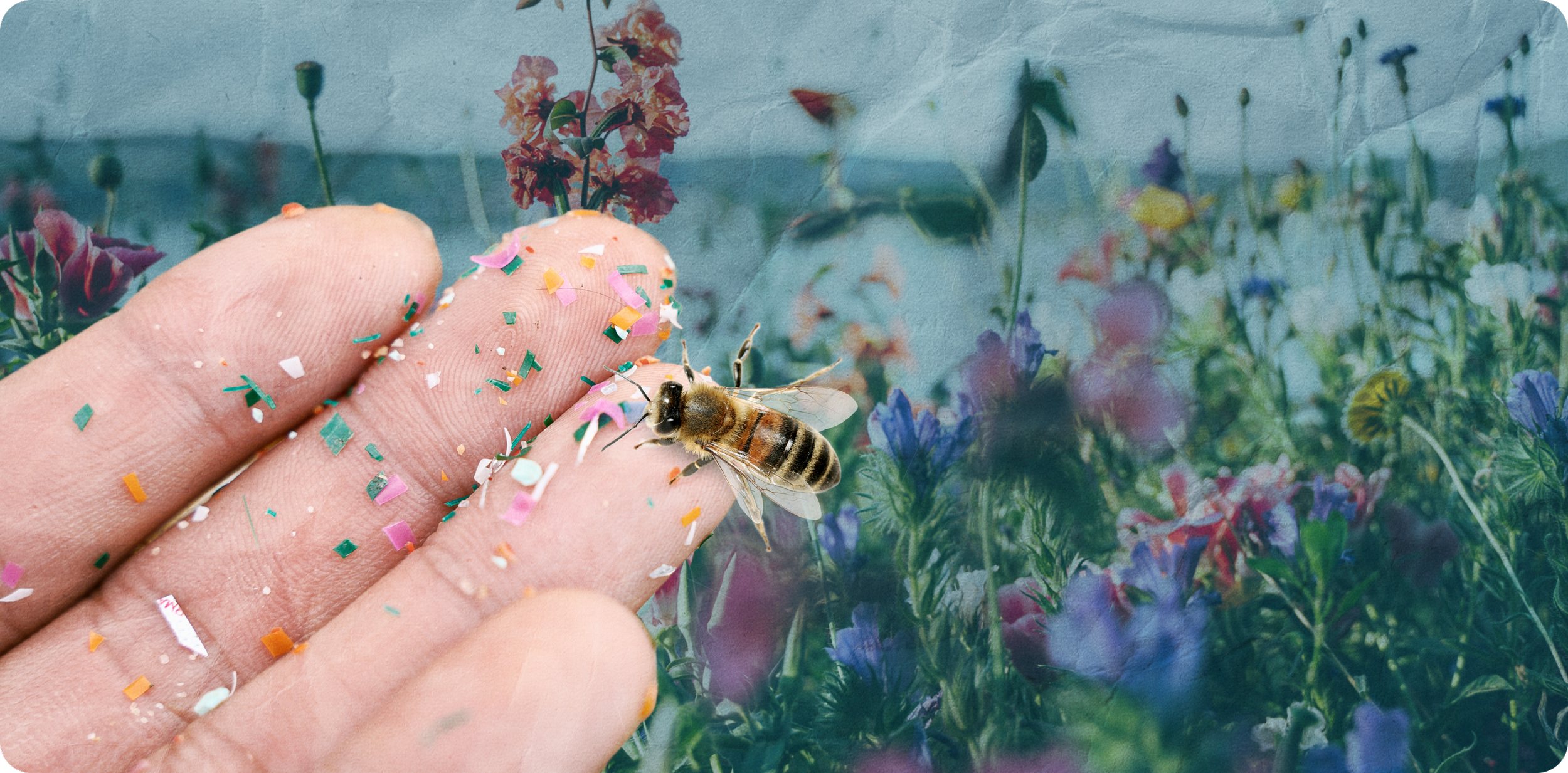How Microplastics Are Harming Bees
We’ve known for a while that our pollinators are in trouble. Pesticides, habitat loss, disease, and climate change have all taken their toll.¹²³ But there’s a new threat — smaller than a grain of sand, sometimes invisible to the human eye, and deeply concerning: microplastics.
Why bees matter (to you, your food, and the planet)
Bees are the unsung heroes of our food system. About one in every three bites of food you eat exists because of a pollinator. Crops like apples, almonds, blueberries, coffee and more all rely on bees doing what they do best: collecting nectar and unknowingly fertilizing the plants we depend on.⁴
Without bees, our food chain and ecosystems would be out of balance.
The invisible enemy: microplastics
Chances are you’ve heard a lot lately about microplastics. They’re tiny pieces of plastic less than 5 mm long. They shed from larger pieces of plastics, as well as broken-down packaging, synthetic clothing, tires, and the dust floating through our homes. Now, they’re showing up on flowers, in water puddles, and even inside beehives.
Recent studies have found microplastic fibers embedded in bees’ guts, brains, and even their honey. How? Through the water they sip, pollen tainted by airborne plastic, and the flowers they’re trying to pollinate.
What happens to bees exposed to microplastics
Scientists are sounding the alarm. Bees exposed to microplastics show signs of confusion — they forget the scents of flowers they once associated with food. That may seem small, but for a bee, it’s life or death. Their ability to feed the hive depends on those scent memories.⁵
Worse, microplastics weaken bees’ immune systems. They become more vulnerable to infection and are more likely to die from diseases they once could fight off.⁶ And when too many bees die or can’t remember where the food is? The whole colony is threatened.⁵⁶
What this means for us
This isn’t just a bee problem. It’s a human problem.
Microplastics are showing up in honey, in the soil that grows our food, and in the water we drink. They’ve been detected in human blood, breast milk, and lung tissue. The same particles threatening pollinators are finding their way into our homes — and our bodies.
It’s all connected: protecting bees means protecting the systems that sustain us all.
Small swaps, big change
This is the part we love most — action. Because the solution starts with us.
Here are three easy ways to make a difference:
Go plastic-free whenever you can
Choose refillable cleaning products, plastic-free packaging, and reusables such as glass soap dispensers. Every piece of plastic avoided is one less fragment in our ecosystems.Grow a pollinator-safe garden
Plant bee-friendly flowers like lavender, clover, and native wildflowers. Avoid chemical pesticides, and keep water sources clean and shallow for safe sipping.Use your voice
Bees have no voice so it’s up to us to advocate for them. Support local, state, and federal policies that reduce plastic waste and protect pollinator habitats. Share what you’re learning. Collective action helps keep the conversations going.
A shared future
Every small step and conscious choice adds up to big effects. When you choose to reduce plastic, you’re not just helping yourself and your home — you’re building a healthier future for our little pollinating bees who support us, the food and water they need, and their homes, too.
Sources:
1 National Resources Defense Council. (n.d.). Colony Collapse Disorder: Why are bees dying? Retrieved June 23, 2025, from https://www.nrdc.org/stories/colony-collapse-disorder-why-are-bees-dying
2 Friends of the Earth. (n.d.). Reasons why bees are dying. Retrieved June 23, 2025, from https://foe.org/blog/reasons-why-bees-are-dying/
3 Planet Bee Foundation. (n.d.). Why bees are dying. Retrieved June 23, 2025, from https://www.planetbee.org/resources/why-bees-are-dying
4 U.S. Department of Agriculture. (n.d.). The importance of pollinators. Retrieved June 23, 2025, from https://www.usda.gov/about-usda/general-information/initiatives-and-highlighted-programs/peoples-garden/importance-pollinators
5 Pasquini, E., Ferrante, F., Passaponti, L., Pavone, F. S., Costantini, I., & Baracchi, D. (2024). Microplastics reach the brain and interfere with honey bee cognition. Science of The Total Environment, 912, 169362. Retrieved June 23, 2025, from https://www.sciencedirect.com/science/article/pii/S0048969723079925
5 Ferrante, F., Pasquini, E., Cappa, F., Bellocchio, L., & Baracchi, D. (2024). Unravelling the microplastic menace: Different polymers additively increase bee vulnerability. Environmental Pollution, 352, 124087. Retrieved June 23, 2025, from https://www.sciencedirect.com/science/article/pii/S0269749124008017
6 Zaraska, M. (2025, April 27). Microplastics may confuse bees and other insects, hurting pollination. The Washington Post. Retrieved June 23, 2025, from https://www.washingtonpost.com/science/2025/04/27/bees-pollination-microplastics-colony-collapse/


